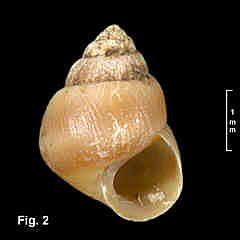|
|
ASSIMINEIDAE |
|
|
|
Cryptassiminea buccinoides (Quoy & Gaimard, 1834) Description: Shell small, solid, spire convex in outline. Protoconch of 2.0 - 2.2 weakly convex whorls, usually eroded. Teleoconch of 4-5 weakly convex whorls, suture impressed, last whorl angled at periphery. Whorls sculptured with weak spiral threads, obsolete on last whorl, usually eroded away. Aperture with peristome entire, outer lip prosocline. Umbilicus closed or narrowly open. Colour fawn with three obscure white spiral bands: below suture, on periphery and on base. Size: Up to 6 mm in length, usually 3-4 mm. Distribution: Endemic to Australia: Cape York, Queensland, southwards to Western Port, Victoria and northern Tasmania Habitat: "Lives in estuaries from high to intermediate salinity in mangroves and saltmarsh. Sometimes found under wood, leaves, etc., but usually on the surface of sediment, often sheltering beneath vegetation" (Fukuda & Ponder, 2005). Comparison: See C. tasmanica for comparison with that species. C. buccinoides is easily confused with another estuarine mollusc Hydrococcus brazieri (Tenison-Woods, 1876), a member of the family Hydrococcidae, to the extent that the two species were mistakenly synonymised by Smith & Kershaw (1979). H. brazieri and C. buccinoides live in similar habitats in mangroves and salt marsh. H. brazieri ocurrs from eastern Victoria across southern Australia to WA, while C. buccinoides is restricted to eastern Australia, with the two species overlapping in eastern Victoria and Tasmania. H. brazieri occurs in north-eastern Victoria.but appears not to reach into southern NSW. Synonymy: There has been much confusion around the name of this species. Originally introduced as Paludina buccinoides Quoy & Gaimard, 1834, the name was incorrectly appropriated for another species, that which is now known as Ascorhis tasmanica. Under the combination Hydrobia buccinoides the name was used for Ascorhis tasmanica by many authors throughout the 20th century, such as by Smith & Kershaw (1979) in their Field Guide to the Non-Marine Molluscs of South Eastern Australia. Remarks: This species is usually eroded, making the fine spiral sculpture and the colour pattern undetectable. Fig. 1 shows a typical eroded adult specimen, and Fig. 2 shows a less eroded juvenile with a clear colour pattern. Before the work of Fukuda & Ponder (2005), the true Paludina buccinoides Quoy & Gaimard, 1834 was regarded as a single species. Fukuda & Ponder, working from anatomical, radula, operculum and shell characters, divided it into seven species, which they placed in the new genus Cryptassiminea . They identified the two species Cryptassiminea buccinoides and Cryptassiminea tasmanica which both occur throughout eastern Australia, and five new species with smaller ranges in eastern and southern Australia. Fig. 1: Moona Moona Creek, Jervis Bay, NSW (C.329335) Fig. 2: Moona Moona Creek, Jervis Bay, NSW (C.329335) |
|

